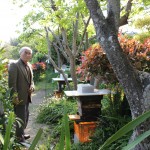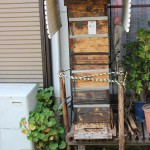This past Saturday I had the opportunity to visit Dr. Tashiro with my wife in Itoshima and talk to him about beekeeping in Japan. He is 90 years old now, and just started keeping native Japanese honey bees (Apis cerana japonica) last year, and this year he has 10 hives around his house, all populated by Japanese honey bee colonies. In Japanese, the word for bee is “hachi” and native honey bees are called “Nihon mitsubachi” or sometimes “Wabachi” for short. European honey bees are called “Seiyou mitsubachi” (translated as Western honey bee) or “Yobachi.” Previous to that, he kept and did research on Yobachi for many years, and consulted with professional beekeekers in Japan, helping them solve their problems.
Dr. Tashiro met us in front of the Maebaru train station, waiting for us in his white car with license plate 3838 (mitsubachi mitsubachi–a play on words) and drove us to his home at the base of a small mountain in Itoshima. After we arrived, his neighbor, Mr. Kinoshita, dropped in. Mr. Kinoshita and his son have a business drilling wells, and his son has been keeping Japanese honey bees for 3 years now and has 30 hives. A little while later his son also joined us and we talked about beekeeping at length. I asked many questions and they did their best to give me the information I was looking for. I am planning to write a book about Japanese beekeeping and this was part of my information gathering in preparation for writing the book. I was able to learn many interesting things which I plan to include in my book.
Mr. Kinoshita’s son said he harvested 80 kilograms of honey from his bees last year and sold it for 1000 yen for 100 ml of honey (in a jar with his personal label–”Ito Honey”). At current exchange rates, that is over $10 for 100 ml. He said he ran out very quickly. Honey from the native honey bees is rarely available, and when it is, it is very expensive. In a department store 100 ml of native honey might cost from $25-$35. Honey of the Western honey bee is much cheaper, and much of it is imported from China because there are so few beekeepers in Japan. Japanese consumers prefer not to buy honey from China if they can help it. The honey from the native bees is also considered to be very medicinal.
We saw two very tall hives with booming bee populations, and a number of smaller hives which were populated with swarms probably just this year. I have included a few pictures to show you.
It turns out that Tashiro sensei’s daughter is married to Elder Yamashita, a new general authority 70 in the LDS church, and they are living in Salt Lake City, Utah. My wife told him how famous his daughter and son-in-law are in our church.



